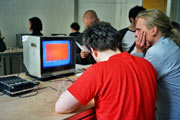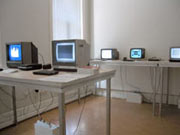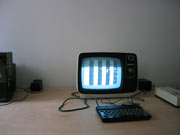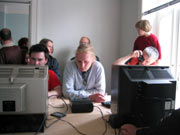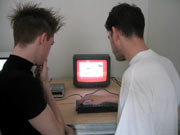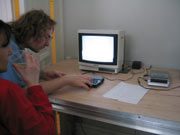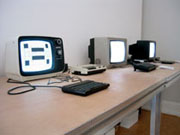| "Rewind the Future" | |
| Joline Blais and Jon Ippolito | |
| When was the last time you sat down to have a talk with your computer? Not to dictate a spreadsheet via keyboard or an e-mail via voice-recognition, but for a heart-to-heart conversation, a back-and-forth exchange? | |
| Computers have been keeping their mouths shut lately, mostly on the advice of their lawyers. That's because loose lips sink media monopolies: Let people's computers talk directly to each other, and they might share software or music. Let people access movie files on a DVD, and they might modify them. So lawyers are advising computers to take the Fifth Amendment. The record labels are pressuring ISPs to reveal students who exploit peer-to-peer networks, then slapping them with million-dollar lawsuits. Microsoft's much-anticipated Longhorn operating system will work together with an Intel chip to hinder "unauthorized" access to a computer and its contents. And Hollywood just announced the amazing self-destructing DVD. | |
| The Art of Monologue | |
| Most digital artists haven't really helped computers express themselves. Yes, Generative and Glitch artists have helped computers find their inner voice through artificial life and software bugs. But the interactivity touted by most new media art is little more than a pre-determined set of social pleasantries: "Hello." "How are you?" "Fine." "Would you like to click here?" "Yes, thank you." | |
| Even artists who haven't taken their cue from the Berlitz phrasebook of multimedia can muzzle their computers simply by their choice of a software package. Since the turn of the century a number of the most prominent Internet artists have turned away from interpreted code like HTML and toward compiled code such as Flash and Java. To be sure, communities of Flash and Java developers commonly post or trade the code that runs their projects behind the scenes--but you have to be a member of those subcultures to know where to look for this code. And once a program is compiled, no one--not ever the original programmer--can amend, append, or interject anything new amidst the FOR loops and function calls. The computer is just executing its own little monologue, mumbling to itself as it carries out the business its creator assigned it. And you can't get a word in edgewise. | |
| It's sad to see 21st-century computers turn tight-lipped, especially because over the last three decades of the 20th they had made so much progress in conversing with people. In 1975, a programmer typically had to use a special typewriter to punch out individual FORTRAN commands on forty or fifty punchcards, arrange these in the right order, wait in line to slip the stack into a mainframe computer's card tray, then wait while the computer first compiled the instructions, then ran the compiled program, then cranked out a response on perforated green-and-white paper. This glacial response time didn't exactly lend itself to fluid banter. "Can you print out all numbers from one to ten?" Twenty minutes later: "Did you say print out all numbers from one two ten?" | |
| Back to BASICs | |
| How did humans and computers get from this awkward stage of their relationship to the chatty conversation of late-twentieth-century script kiddies, where the HTML on someone's Web site could be copied, pasted, modified, and reloaded into a browser in less time than it takes to punch out a single FORTRAN statement? As the artist duo jodi notes, a pivotal moment was the adoption of the BASIC programming language in the early 1980s. As computer scientist Diarmuid Pigott notes: | |
| [BASIC's] code runs in a human-monitored session, complete with the RUN command. It goes off to a compiler and returns error messages immediately. It is the conversational aspect that mattered to [BASIC's designers].... | |
| Granted the designers always intended it to be compiled, not interpreted (this is explicitly stated in Kurz 1978) it still seems to me that to concentrate on the compilation/interpretation dichotomy is to miss the essential features of BASIC, which were the conversational aspects. This interplay between the programmer and the computer was where the real "interpretation" happened: interactive editing of lines of code through numbers, verbs such as LET to require explicit assignment all show how the paradigm was more complex than what is understood now by interpretation, which is closer to the Ousterhout model of scripting vs. compilation. (http://www.kbasic.org/1/history.php3) | |
| Peck, PEEK, POKE | |
| To regain this lost art of conversation, jodi have dug up fossil computers that can run BASIC, with the aim of sparking new dialogues in an ancient language. Visitors to a digital art gallery are confronted with a row of ZX Spectrums--which is the art world equivalent of seeing a line of Model T's in a Concept Car Expo. To interact with these Jurassic devices, visitors must peck out lines of program code on a rubberized keyboard. For the uninitiated, this would be a daunting task for most programming contexts, but here jodi have made the job mercifully simple given the rudimentary commands available in BASIC, which in these ten-line programs merely involve changing the hue or position of blocks of color on the screen. The payoff comes in the speed and ease of conversation: a program can be modified and run with only two or three keystrokes, and it can even be interrupted while in progress via the BREAK command. A ZX Spectrum may not have the most sophisticated vocabulary, but it's a humble and forgiving conversationalist. | |
| And these antiquated twenty-somethings will open their hearts to you, if you know the right things to say. The heart of a computer lies underneath its programming shell, down at the level of the machine code. Ordinary programming languages don't allow such deep access, but BASIC's PEEK statement permits a user to glimpse the contents of a memory location directly. Not only will the Spectrum let you see its memories, but it will even let you change them. The POKE statement stores a number directly in memory location, bypassing the mechanisms normally used by a programming shell. Jodi call this direct access to a computer's innermost memories "open hardware," and it is a kind of interaction ordinary folks are unaccustomed to having with the chunk of silicon sitting on our desktops. | |
| Power Games | |
| Why do we want to talk with our computers, anyway? Because code is power. If we can talk to our computers and control them, we can have some say in the ways they control us. Jodi's little game of colored blocks is a nostalgic rewind to a time before today's yawning divide between code and content, between depth and surface. By contrast, the overwhelming majority of contemporary games offer not access to code, but a replacement for access to code. Code structures have gotten so knotted up in Byzantine 50-megabyte releases that even programmers feel out of the (DO) loop. When a geek gets a rush from beheading an adversary in Mortal Kombat, the thrill is partial compensation for the fact that no single programmer could create Mortal Kombat himself. A game is a power fantasy, but a game's only real power lies in the code that drives it. Jodi's installation hands over the keys to us ordinary mortals: here, you drive for a change. | |
| What happens when stories get copyrighted or game code becomes closed? Hollywood plots, hack fiction, and juvenile games. But it's not only the quality of our entertainment that is endangered when code is hidden away from a community of users. | |
| Evolution teaches us that closed systems eventually perish, and that only diverse, open systems create the conditions under which life can thrive. Even if we narrow the focus to languages, philosopher Mikhail Bakhtin reminds us that Saussurian "langues" are dead, and that only live, open "paroles" remain relevant to the polyphonic communities that deploy them. As long as computer codes remain largely in the hands of Microsoft and SONY, then they risk the fate of becoming increasingly irrelevant to the communities that they attempt to control. And when that happens the demand in gaming for bigger and bigger guns to defeat bigger and bigger foes will only increase, as our sense of powerlessness increases. | |
| Mirror Stage | |
| If it is the conversational aspect of coding that matters, then who are we talking to when we talk to our computers? Open source and open hardware, for all their utopian promise, do not always open up the larger world we live in. When people talked to MIT's Eliza via a text interface, they insisted this virtual Rogerian analyst was capable of meaningful conversations with them. But Eliza was only a set of algorithms acting as a mirror. | |
| Much of jodi’s work invites us to pay attention to what we see in the mirror of computer gaming. Their 2001 work Untitled Game reenacts the violence of computer games by equating it with the violence of computer crashes. When the target of the violence suddenly becomes ourselves--or our hard drives--we are shocked and awed by the assault. War games are played by us, against them. We don’t expect our projectiles to be redirected back at us. We don’t expect our own planes to crash into the Twin Towers. | |
| Whatever the momentary satisfaction or shock of standalone computer games, they are ultimately isolating. And so is the code, if all the code does is give us a mirror of ourselves, translating our material world into configurable bits and bytes. If what we want from code is not only power, but also discourse and connection, then perhaps we should begin to ask ourselves about the codes we are in the habit of overlooking in our preoccupation with our own, whether digital or genomic: cicada hisses and dolphin pings, the groans and shrugs of our teenagers, Rap Star wannabes on Columbus Avenue, the pattern of planned settlement in the West Bank. There are plenty of codes out there calling for our attention, and many are in plain sight or hearing. If access to digital code can open up the heart of a computer, would a deeper understanding of these other codes enable us to open our own codes--and our own hearts? If not, in our search for bigger and better guns--virtual and real--with which to obliterate the exaggerated foes of our latest war games, we may find ourselves closing the door on our future. | |
| Biography | |
| Jon Ippolito | |
| The recipient of Tiffany, Lannan, and American Foundation awards, Jon Ippolito has exhibited artwork with collaborative teammates Janet Cohen and Keith Frank at the Walker Art Center, ZKM/Center for Art and Media Karlsruhe, and WNET's ReelNewYork Web site. As Associate Curator of Media Arts at the Guggenheim Museum, he has curated _Virtual Reality: An Emerging Medium_ and, with John G. Hanhardt, _The Worlds of Nam June Paik_. Ippolito's critical writing has appeared in periodicals ranging from Flash Art and the Art Journal_ to the _Washington Post_. At the Still Water lab co-founded with Joline Blais, Ippolito is at work on three projects--the Variable Media Network, the Open Art Network, and an exhibition called Mind Sets--that aim to expand the art world beyond its traditional confines. | |
| Joline Blais | |
| Fiction writer Joline Blais is an Assistant Professor of New Media at the University of Maine and co-founder of Still Water for network art and culture. Informed by a background in comparative literature at Harvard and University of Pennsylvania, she previously directed the Digital Media Studies program at New York's Polytechnic University and pioneered the teaching of media technologies in SCPS at New York University. Blais' research explores new narrative mediums, from DHTML to Weblogs to gaming platforms; her writing explores the way that introducing alternative viewpoints can destabilize the traditional plots found in mainstream literature and cinema. She and Jon Ippolito are currently at work on a book entitled _The Edge of Art_. She has also recently completed _Sorties_, her first novel. | |
